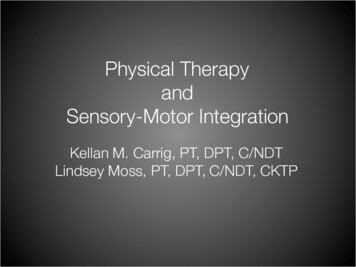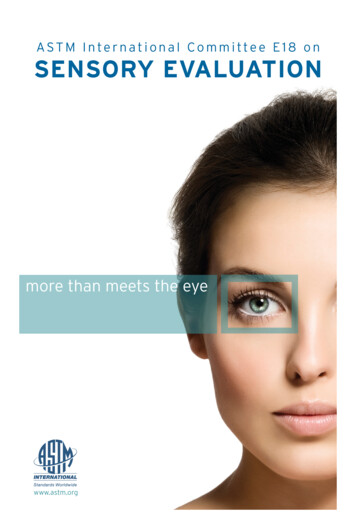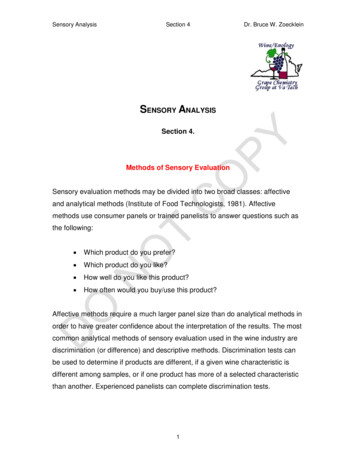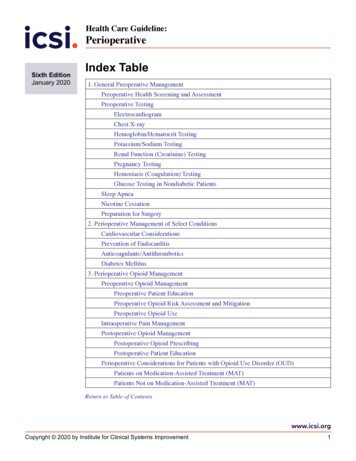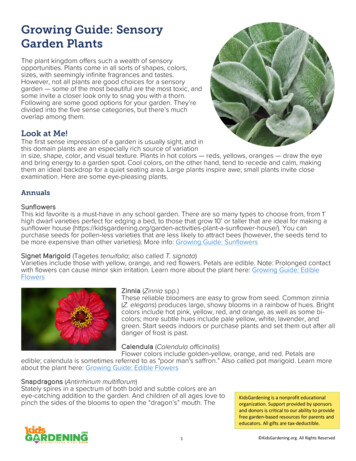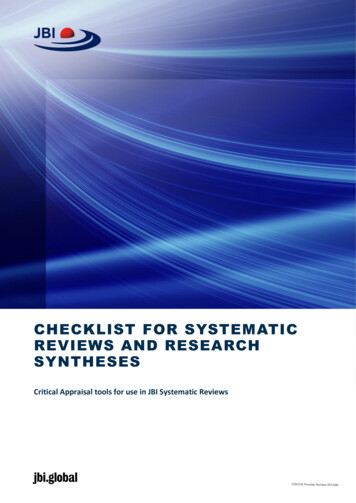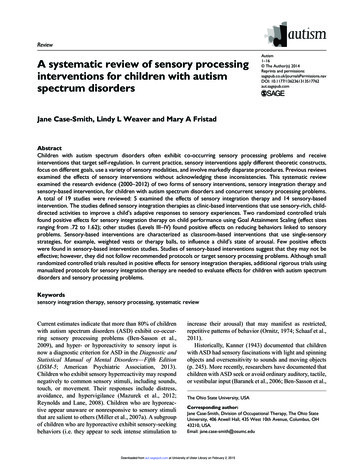
Transcription
17762AutismCase-Smith et al.ReviewA systematic review of sensory processinginterventions for children with autismspectrum disordersAutism1 –16 The Author(s) 2014Reprints and OI: 10.1177/1362361313517762aut.sagepub.comJane Case-Smith, Lindy L Weaver and Mary A FristadAbstractChildren with autism spectrum disorders often exhibit co-occurring sensory processing problems and receiveinterventions that target self-regulation. In current practice, sensory interventions apply different theoretic constructs,focus on different goals, use a variety of sensory modalities, and involve markedly disparate procedures. Previous reviewsexamined the effects of sensory interventions without acknowledging these inconsistencies. This systematic reviewexamined the research evidence (2000–2012) of two forms of sensory interventions, sensory integration therapy andsensory-based intervention, for children with autism spectrum disorders and concurrent sensory processing problems.A total of 19 studies were reviewed: 5 examined the effects of sensory integration therapy and 14 sensory-basedintervention. The studies defined sensory integration therapies as clinic-based interventions that use sensory-rich, childdirected activities to improve a child’s adaptive responses to sensory experiences. Two randomized controlled trialsfound positive effects for sensory integration therapy on child performance using Goal Attainment Scaling (effect sizesranging from .72 to 1.62); other studies (Levels III–IV) found positive effects on reducing behaviors linked to sensoryproblems. Sensory-based interventions are characterized as classroom-based interventions that use single-sensorystrategies, for example, weighted vests or therapy balls, to influence a child’s state of arousal. Few positive effectswere found in sensory-based intervention studies. Studies of sensory-based interventions suggest that they may not beeffective; however, they did not follow recommended protocols or target sensory processing problems. Although smallrandomized controlled trials resulted in positive effects for sensory integration therapies, additional rigorous trials usingmanualized protocols for sensory integration therapy are needed to evaluate effects for children with autism spectrumdisorders and sensory processing problems.Keywordssensory integration therapy, sensory processing, systematic reviewCurrent estimates indicate that more than 80% of childrenwith autism spectrum disorders (ASD) exhibit co-occurring sensory processing problems (Ben-Sasson et al.,2009), and hyper- or hyporeactivity to sensory input isnow a diagnostic criterion for ASD in the Diagnostic andStatistical Manual of Mental Disorders—Fifth Edition(DSM-5; American Psychiatric Association, 2013).Children who exhibit sensory hyperreactivity may respondnegatively to common sensory stimuli, including sounds,touch, or movement. Their responses include distress,avoidance, and hypervigilance (Mazurek et al., 2012;Reynolds and Lane, 2008). Children who are hyporeactive appear unaware or nonresponsive to sensory stimulithat are salient to others (Miller et al., 2007a). A subgroupof children who are hyporeactive exhibit sensory-seekingbehaviors (i.e. they appear to seek intense stimulation toincrease their arousal) that may manifest as restricted,repetitive patterns of behavior (Ornitz, 1974; Schaaf et al.,2011).Historically, Kanner (1943) documented that childrenwith ASD had sensory fascinations with light and spinningobjects and oversensitivity to sounds and moving objects(p. 245). More recently, researchers have documented thatchildren with ASD seek or avoid ordinary auditory, tactile,or vestibular input (Baranek et al., 2006; Ben-Sasson et al.,The Ohio State University, USACorresponding author:Jane Case-Smith, Division of Occupational Therapy, The Ohio StateUniversity, 406 Atwell Hall, 435 West 10th Avenue, Columbus, OH43210, USA.Email: jane.case-smith@osumc.eduDownloaded from aut.sagepub.com at University of Ulster Library on February 2, 2015
2Autism2009; Rogers and Ozonoff, 2005), suggesting impairmentin sensory modulation across systems (Dahlgren andGillberg, 1989). Specific sensory modulation problemsreported by people with ASD (e.g. Grandin, 1992;Williams, 1995) include hyperreactivity to touch orsounds, hyporeactivity to auditory input, and unusual sensory interests. The most common type of sensory modulation problem in ASD appears to be hyporeactivity,particularly in social contexts (Baranek et al., 2006). Ameta-analysis of sensory modulation symptoms in ASDfound that effect sizes for the differences between childrenwith and without ASD were greatest for hyporeactivity (d 2.02) but also notable for hyperreactivity (d 1.28) andsensory-seeking (d .83) (Ben-Sasson et al., 2009).Although sensory processing problems appear to be greaterin childhood (Ben-Sasson et al., 2009), they are selfreported to be lifelong (Grandin, 1995).Sensory processing problems in ASD are believed to bean underlying factor related to behavioral and/or functional performance problems. Ornitz (1974) hypothesizedthat sensory modulation problems are related to the stereotypic or repetitive behaviors displayed by children withASD, and that the stereotypic behaviors reflect the child’sattempt to lower arousal (self-calm) or increase arousal(sensory-seeking). Researchers have attributed repetitivemovements, such as rocking, twirling, or spinning behaviors, to sensory processing problems (Ornitz et al., 1978;Rogers et al., 2003; Schaaf et al., 2011). Joosten and Bundy(2010) found that a sample of children with ASD and stereotypical behaviors had significantly greater sensory processing problems (d 2.0) than do typical children. Rigidbehaviors (e.g. refusing to transition to a new activity, preferring a rigid routine) or preference for sameness mayalso be motivated by hyper- or hyporeactivity (Lane et al.,2010).Sensory processing problems in ASD may also influence a child’s functional performance in daily activities,such as eating, sleeping, and daily routines, including bathtime and bedtime behaviors (Schaaf et al., 2011). Childrenwith selective eating often have olfactory and/or gustatoryoversensitivities that can cause aversion to certain foods(Leekam et al., 2007; Paterson and Peck, 2011).Hyperreactivity or aversion to tastes or smells can lead toanxiety or rigidity about eating and these states can evolveinto disruptive and stress-producing behaviors at mealtime(Cermak et al., 2010). Sensory processing problems canalso disrupt children’s sleeping patterns; Reynolds et al.(2012) found that children with ASD and sensory modulation problems have poor sleeping patterns, specificallyhave difficulty falling asleep, and that these problemsappear to relate to sensory modulation. Between 50% and80% of children with ASD have sleeping difficulties(Richdale and Schreck, 2009) that seem to relate, at leastin part, to sensory processing problems (Klintwall et al.,2011; Reynolds and Malow, 2011).Sensory processing problems have also been linked toanxiety in children with ASD. Green and Ben-Sasson(2010) proposed a model to explain how hyperreactivity inchildren with ASD can be characterized as hyper-attentionto sensory stimuli and overreaction to those stimuli.Hyperreactivity can lead to overarousal, difficulty regulating negative emotion, and avoidance or negative responsesto everyday sensory stimuli. Over time, poor regulation ofarousal may result in anxiety (Bellini, 2006) and may beparticularly stressful for the nonverbal child who lackscommunication skills to express his or her anxiety (Greenand Ben-Sasson, 2010). In a large sample of children withASD and gastrointestinal problems, sensory hyperreactivity correlated with anxiety levels, and hyperreactivity andanxiety uniquely contributed to gastrointestinal symptoms(Mazurek et al., 2012).Although studies have demonstrated that sensory processing problems can influence the behavior of childrenwith ASD, the relationships among sensory-driven behaviors, arousal, self-regulation, attention, activity levels, andstereotypic behaviors are not well understood. When sensory processing problems are believed to influence achild’s behavior, interventions that use sensory modalitiesto support self-regulation, promote optimal arousal,improve behavioral organization, and lower overreactivityare often recommended.Interventions for sensory processingdisordersDespite wide recognition of sensory processing problemsand their effects on life participation for individuals withASD, sensory interventions have been inconsistentlydefined and refer to widely varied practices. As found inthe literature and in practice, sensory interventions use avariety of sensory modalities (e.g. vestibular, somatosensory, and auditory), target behaviors that may or may notbe associated with sensory processing disorder, involve acontinuum of passive to active child participation, and areapplied in different contexts. These interventions arisefrom different conceptualizations about sensory integration and sensory processing as neurological and physiological functions that influence behavior. Furthermore,they use a variety of methods (e.g. sensory integrationtherapy (SIT) (Ayres, 1972), massage (Field et al., 1997),and auditory integration training (Bettison, 1996)). Thisvariation in sensory interventions combined with inconsistent use of terminology has resulted in considerableconfusion for parents, practitioners, and researchers. Withdisparate and sometimes conflicting rationale for usingsensory interventions for ASD, researchers have hypothesized that they can inhibit stereotypical behaviors (e.g.Davis et al., 2011), reduce self-injurious behaviors (e.g.Devlin et al., 2009; Smith, et al. 2005), improve attentionto task (e.g. Watling and Dietz, 2007), increase sitting timeDownloaded from aut.sagepub.com at University of Ulster Library on February 2, 2015
3Case-Smith et al.(e.g. Hodgetts et al., 2010; Schilling and Schwartz, 2004),elicit adaptive responses (Schaaf et al., 2013), and improvesensory motor performance (Fazlioglu and Baran, 2008).Although researchers have applied sensory interventionsto improve behaviors hypothesized to reflect self-regulation, most studies did not use neurophysiological measuresand many did not include sensory processing measures(e.g. Bonggat and Hall, 2010; Kane et al., 2004). Despiteinconsistency in the research literature, sensory interventions are among the services most requested by parents ofchildren with ASD (Green et al., 2006). Over 60% of children with ASD receive sensory interventions, often incombination with other therapies, making it one of themost common types of service for ASD (Green et al.,2006). With incomplete and contradictory findings fromresearch, the field lacks consensus as to what sensoryinterventions families should seek and practitioners canrecommend.To increase understanding of the different types of sensory interventions and to assess the evidence, we distinguish SIT, a clinic-based, child-centered interventionoriginally developed by Ayres, that provides play-basedactivities with enhanced sensation to elicit and reinforcethe child adaptive responses, and sensory-based intervention (SBI), structured, adult-directed sensory strategiesthat are integrated into the child’s daily routine to improvebehavioral regulation.SITSIT is a clinic-based intervention that uses play activitiesand sensory-enhanced interactions to elicit the child’sadaptive responses. The therapist creates activities thatengage the child’s participation and challenge the child’ssensory processing and motor planning skills (Ayres,1972; Koomar and Bundy, 2002; Parham and Mailloux,2010). Using gross motor activities that activate the vestibular and somatosensory systems (Mailloux and Roley,2010), the goal of SIT is to increase the child’s ability tointegrate sensory information, thereby demonstratingmore organized and adaptive behaviors, includingincreased joint attention, social skill, motor planning, andperceptual skill (Baranek, 2002). The therapist designs a“just-right” skill challenge (i.e. an activity that requires thechild’s highest developmental skills) from the child’s repertoire of emerging skills and supports the child’s adaptiveresponse to the challenge (Vygotsky, 1978; Watling et al.,2011). Traditional SIT is provided in a clinic with speciallydesigned equipment (e.g. swings, therapy balls, innertubes, trampolines, and climbing walls) that can providevestibular and proprioceptive challenges embedded inplayful, goal-directed activities.A widely used fidelity measure defines the active ingredients or essential elements of clinic-based SIT (Parhamet al., 2007, 2011). Each element is individualized to thechild and targets specific objectives. The 10 essential elements are as follows: (a) ensuring safety, (b) presenting arange of sensory opportunities (specifically tactile, proprioceptive, and vestibular), (c) using activity and arranging the environment to help the child maintainself-regulation and alertness, (d) challenging postural,ocular, oral, or bilateral motor control, (e) is challengingpraxis and organization of behavior, (f) collaborating withthe child on activity choices, (g) tailoring activities to present the “just-right challenge,” (h) ensuring that activitiesare successful, (i) supporting the child’s intrinsic motivation to play, and (j) establishing a therapeutic alliance withthe child (Parham et al., 2007, 2011).In addition to working directly with the child, the therapist reframes the child’s behaviors to the parent or clinicianusing a sensory processing perspective (Bundy, 2002;Parham and Mailloux, 2010). Explaining the possible linksbetween sensory processing and challenging behaviors,then recommending strategies that target the child’s hyperor hyporeactivity, can help caregivers and other treatmentproviders develop different approaches to accommodate thechild’s needs. By modifying the child’s environments orroutines to support self-regulation, the child can more fullyparticipate in everyday activities. Recommended modifications to the child’s daily routines or environments often promote a balance of active and quiet activities and opportunitiesfor the child to participate in preferred sensory experiences(e.g. swinging in the backyard or neighborhood playground,climbing on a gym set, supervised trampoline jumping, andquiet rhythmic rocking in a low lit bedroom).SBIsSBIs are adult-directed sensory modalities that are appliedto the child to improve behaviors associated with modulation disorders. SBIs require less engagement of the childand are intended to fit into the child’s daily routine. For thepurposes of this review, similar to Lang et al. (2012) andMay Benson and Koomar (2010), only SBIs that activatesomatosensory and vestibular systems and are believed topromote behavioral regulation were included, for example,brushing, massage, swinging, bouncing on a therapy ball,or wearing a vest. As in SIT, these interventions are basedon the hypothesis that the efficiency with which the child’snervous system interprets and uses sensory informationcan be enhanced through systematic application of sensation to promote change in arousal state (Parham andMailloux, 2010). SBIs, like SIT, are based on neurosciencemodels (e.g. Kandel et al., 2000; Lane, 2002) and clinicalobservations (Mailloux and Roley, 2010) supporting thatcertain types of sensory input, for example, deep touch androcking, are calming and organizing, and that rhythmicapplication of touch (e.g. brushing) or vestibular sensation(e.g. linear swinging) has an organizing effect that promotes self-regulation (Ayres, 1979; Parham and Mailloux,Downloaded from aut.sagepub.com at University of Ulster Library on February 2, 2015
4Autism2010). A key feature of these techniques is that they aredesigned to influence the child’s state of arousal, mostoften to lower a high arousal state such as agitation, hyperactivity, or self-stimulating behaviors.Most SBIs, such as weighted blankets, pressure vests,brushing, and sitting on a ball, are used in the child’s natural environment (rather than a clinic), are integrated intothe child’s daily routine (i.e. used as needed according tothe child’s arousal), and are applied by family members,teachers, or aides (i.e. an occupational or physical therapistdoes not administer) (e.g. Wilbarger and Wilbarger, 2002).SBIs have evolved from therapists observing how childrenrespond to the sensation (Ayres, 1972; Koomar and Bundy,2002); therefore, the sensory techniques have not beensystematically developed through research into a manualized intervention. Most research studies on SBIs haveexamined the effects of a single-sensory strategy on behaviors that reflect the child’s arousal or self-regulation.For purposes of this systematic review, we define SBIsas those that (a) are based on specific assessment of thechild’s performance, development, and sensory needs; (b)include stated goals of self-regulation and related behavioral outcomes; and (c) require the child’s active participation. Examples of sensory interventions that meet thesecriteria include sitting on a therapy ball, swinging, andwearing a pressure or weighted vest when used to promotecalming, enhance self-regulation, or improve behavior.Evidence-based practice guidelines and fidelity measureshave not been developed for these interventions. Theseinterventions have been recommended or applied by educators, psychologists, occupational therapists, and paraprofessionals, often without a specific protocol.Systematic reviews of SIT and SBIPrevious systematic SIT reviews using samples of childrenwith learning disabilities, attention deficit hyperactivitydisorder (ADHD), and developmental coordination disorder have reported moderate effect sizes for motor and academic outcomes when SIT was compared to no treatment(Polatajko et al., 1992; Vargas and Camilli, 1999). Thesereviews concluded that SITs were as effective as alternative treatments (e.g. no different than perceptual motoractivities) (Vargas and Camilli, 1999).For SIT with children with ASD, three relevant systematic reviews examined sensory motor (Baranek, 2002),occupational therapy interventions (Case-Smith andArbesman, 2008), and SBIs (Lang et al., 2012). The twoformer reviews defined SIT and SBI broadly, includingauditory integration therapy (electronically filtered musicthrough high-resolution head phones) and motor activity/exercise (Baranek, 2002; Case-Smith and Arbesman,2008), that are excluded in the current review. Using thesemore inclusive definitions of SIT and SBI, Case-Smith andArbesman (2008) and Baranek (2002) found low-levelevidence (Levels III and IV) that these interventionsimproved social interaction, increased purposeful play,and reduced hyperreactivity in young children. Eachreview concluded that the evidence for SIT and SBI wasuncertain, noting that sensory intervention studies demonstrated methodological constraints, including conveniencesamples, observer bias, and inadequate controls (Baranek,2002; Case-Smith and Arbesman, 2008). These researchers recommended that future SIT/SBI research focus onfunctional outcomes (in addition to sensory processingmeasures), link physiological and functional measures,and include long-term outcomes. In a recent review thatcombined SIT and SBI, Lang et al. (2012) appraised 25studies of SIT (n 5) and SBI (n 20 (10 examined use ofa weighted vest)). Like the other reviews, the majority offindings were “suggestive” given that 19 studies used single-subject design (Level IV evidence).The current systematic review updates these reviews,focuses on interventions that activate the somatosensory andvestibular systems, and differentiates between SIT, based onthe original work of Ayres and manualized by Parham et al.(2011), and SBI, that applies specific types of sensory inputhypothesized to effect self-regulation. This review also differs from Lang et al. (2012) by including only studies inwhich the participants had evidence of sensory processingproblems (eliminating research that applied SBIs to behaviors that were not linked to sensory processing measures).Purpose of this studyGiven the evidence for co-occurring sensory processingproblems in children with ASD and the need to identify theevidence base for sensory interventions, this systematicreview examined the following research question: What isthe effectiveness of SIT and SBIs for children with ASDand co-occurring sensory processing problems on selfregulation and behavior?MethodsLiterature searchSeveral strategies were used to identify studies for thisreview. A computerized search of references publishedbetween 2000 and 2012 was conducted using the following electronic databases: WorldCat (Social SciencesAbstracts, Academic OneFile, and Academic SearchComplete); MEDLINE, ERIC, CINAHL, and thePsychology & Behavioral Sciences Collection. Referencelists from identified articles, systematic reviews, and practice guidelines for SBIs (Watling et al., 2011) were handsearched to ensure that a comprehensive list of relevantarticles was considered for inclusion.Various combinations of the following key words andsearch terms were used to identify pertinent articles:Downloaded from aut.sagepub.com at University of Ulster Library on February 2, 2015
5Case-Smith et al.Titles/Abstracts iden fied andassessed for inclusion (N 1540)Excluded (n 1450) Did not meet inclusion criteria #1-3:- Peer-reviewed- Ages 3-21- Studied SIT or SBIAbstracts eligible forreview (n 90)Excluded (n 71) Did not meet inclusion criterion #4, 5- Diagnosed with ASD- Targeted self-regula onFull-Text Review (n 19)5 SIT studies14 SBI studiesFigure 1. Flow diagram outlining results of published literature search and included studies.SIT: sensory integration therapy; SBI: sensory-based intervention; ASD: autism spectrum disorder.sensory integration, sensory processing, sensory-based,sensory, psychiatry, psychology, self-regulation, mentalhealth, occupational therapy, developmental disorder, andautism. Inclusion criteria were as follows: (a) peerreviewed studies published in English, (b) participantswere youth aged 3–21 years, (c) an SIT or SBI was studied, (d) participants were diagnosed with ASD, and (e) theintervention systematically (i.e. was based on stated goals)targeted self-regulation and arousal state.A total of 1540 references were identified through theoriginal search process (see Figure 1). Based upon title andabstract screening, 1450 articles were excluded as they didnot meet inclusion criteria #1–3. The remaining 90abstracts were reviewed. Of those, 71 were excludedbecause they did not meet inclusion criterion #4 or 5. Theremaining 19 studies were selected for full text review byJ.C.-S. and L.L.W.AnalysisJ.C.-S. and L.L.W. analyzed the studies that met inclusion criteria and extracted the following data: (a)research objectives, (b) research design, (c) participantcharacteristics, (d) intervention, (e) outcome measures,and (e) findings. We used criteria developed for bothrehabilitation and psychology research as these studiesare published in the medical, education, and psychologyliterature. Overall rigor of the methodology was ratedaccording to PEDro scale (De Morton, 2009), commonly used in occupational therapy (the field mostlikely to provide sensory interventions) or physicaltherapy to judge the rigor of clinical trials (see Centerfor Evidence-Based Medicine Levels of Evidence(http://www.cebm.net) and Physiotherapy EvidenceDatabase (http://www.pedro.org.au)). The PEDro scalehas 10 criteria that are scored 1 for “yes” or 0 for “no”and summed as x/10. We also used the psychologyguidelines for evidence-based treatments (Chamblessand Hollon, 1998; Nathan and Gorman, 2007) to raterigor of each study (Types 1–6). The authors rated thestudies independently, compared and discussed scores,and agreed on consensus scores. Table 1 presents thecriteria used to analyze the studies.Study characteristics are summarized in Table 2.Findings were synthesized in terms of type of interventionand effects on targeted outcomes. An average effect sizewas not calculated, as 15 of 19 studies used single-subjector case report designs.Downloaded from aut.sagepub.com at University of Ulster Library on February 2, 2015
6AutismTable 1. Common systems to describe levels of evidence and criteria used to analyze studies in psychology and occupationaltherapy.Randomized controlled trial(RCT) criteria (Chamblessand Hollon, 1998; Nathan andGorman, 2007)Types of studies (Chamblessand Hollon, 1998; Nathanand Gorman, 2007)PEDro scale (PhysiotherapyEvidence Database), scoresrange from 0 to 10Levels of evidence (Centerfor Evidence-Based Medicine)Should include: Comparison groups withrandom assignment Blinded assessments Clear inclusion andexclusion criteria Standardized assessment Adequate sample size forstatistical power Intervention manual Fidelity measure Clearly described statisticalmethods Follow-up measures Type 1: most rigorous,randomized, prospectiveclinical trial that meets allcriteria Type 2: clinical trial, atleast one aspect of theType 1 study is missing Type 3: clinical trial that ismethodologically limited,for example, a pilot studyor open trial Type 4: review ofpublished data, forexample, meta-analyses Type 5: reviews that donot include secondarydata analyses Type 6: case studies,essays, and opinion papers Random allocation used Allocation concealed Groups comparable atbaseline Blinding of participants Blinding of all studytherapists Blinding of all assessorswho measured at leastone key outcome Outcome measuresobtained from more than85% of the initial sample Intent-to-treat analysesused Between-group statisticalcomparisons reported Pre/post-measures andmeasures of variabilityreported (or effect sizesreported) Level I: systematic review(of RCTs) or RCTconducted Level II: systematic reviewof cohort studies; lowquality RCT; individualcohort study; outcomesresearch Level III: systematicreview of case-controlstudies; individual casecontrol study Level IV: case series;poor quality case-controlstudies Level V: expert opinionwithout explicit criticalappraisalCenter for Evidence-Based Medicine (http://www.cebm.net) (Chambless and Hollon, 1998; Nathan and Gorman, 2007); Physiotherapy EvidenceDatabase PEDro scale (http://www.pedro.org.au).ResultsA total of 19 studies published since 2000 met inclusioncriteria. Five examined the effects of SIT and 14 examinedthe effects of a SBI on children with ASD and sensory processing problems (see Table 2).SIT effectsTwo of the five SIT studies were randomized controlledtrials (RCTs); one RCT compared SIT to usual care, onecompared SIT to a fine motor activity protocol, and onewas a case report. All five studies used participants withASD and sensory processing disorders and applied a manualized SIT approach based on the original work of Ayres(1972, 1979). Four studies (Pfeiffer et al., 2011; Schaafet al., 2012; Schaaf et al., 2013; Watling and Dietz, 2007)documented high fidelity using the published fidelitymeasure described earlier (Parham et al., 2007). RCTresults suggest that SIT is associated with positive effectsas measured by the child’s performance on GoalAttainment Scaling (GAS) (Pfeiffer et al., 2011; Schaafet al., 2013), decreased autistic mannerisms (Pfeifferet al., 2011), and improved (i.e. less caregiver assistancerequired) self-care and social function (Schaaf et al.,2013). Treatment effects on GAS, as rated by a blindedtherapist who interviewed the parents, were moderate tohigh (Pfeiffer et al. (η .36) and Schaaf et al. (d 1.17)),reflecting child improvement on targeted goals as measured by teachers and parents. Schaaf and her colleaguesalso demonstrated moderate effects on sensory perceptualbehaviors (d .6).In the nonrandomized SIT trial, seven children withlow-functioning ASD who exhibited self-injurious andself-stimulating behaviors received alternating SIT andbehavioral intervention conditions (Smith et al., 2005).The children showed fewer problem behaviors 1 h afterSIT than 1 h after behavioral interventions (p .02) andproblem behaviors declined from weeks 1 to 4 (p .04),suggesting that in children with sensory processing problems, SIT may reduce self-injurious and self-stimulatingbehaviors more than behavioral interventions. In the casereport by Schaaf et al. (2012), a 5-year-old with ASD andADHD improved in ritualistic behaviors, resistance tochange, specific fears, and individualized goals as measured by the GAS. Using an ABAB single-subject designwith four preschool children, Watling and Dietz (2007)examined the immediate effects of SIT compared to abaseline condition on engagement and behavior during atabletop activity but found no effect for SIT. These authorsnoted that a ceiling effect limited their ability to detectchange in performance.Downloaded from aut.sagepub.com at University of Ulster Library on February 2, 2015
To investigate the effects ofoccupational therapy using asensory integrative approach onone child with ASD and sensoryprocessing difficultyTo evaluate the effects of SIintervention on children withASD in comparison to usualcareTo compare the effects of SITand a control intervention onself-stimulating and self-injuriousbehaviors (SSB and SBI) in youthwith severe/profound PDDand MRSchaaf et al.(2013)Smith et al.(2005)To determine feasibility, identifyappropriate outcome measures,and address effectiveness of SIinterventions in children withASDObjectivesSchaaf et al.(2012)SITPfeiffer et al.(2011)StudyType 3; RCT (randomassignment, not blinded);manualized intervention, fidelitymeasure; PEDro score 6/10;CEBM Level IChildren with ASD; (26 males,6 females); N 32; ages 56–83SI group (n 17) usual caregroup (n 15)Type 3: two-group
therapy (SIT) (Ayres, 1972), massage (Field et al., 1997), and auditory integration training (Bettison, 1996)). This variation in sensory interventions combined with incon-sistent use of terminology has resulted in considerable confusion for parents, practitioners, and researchers. With disparate and sometimes conflicting rationale for using
